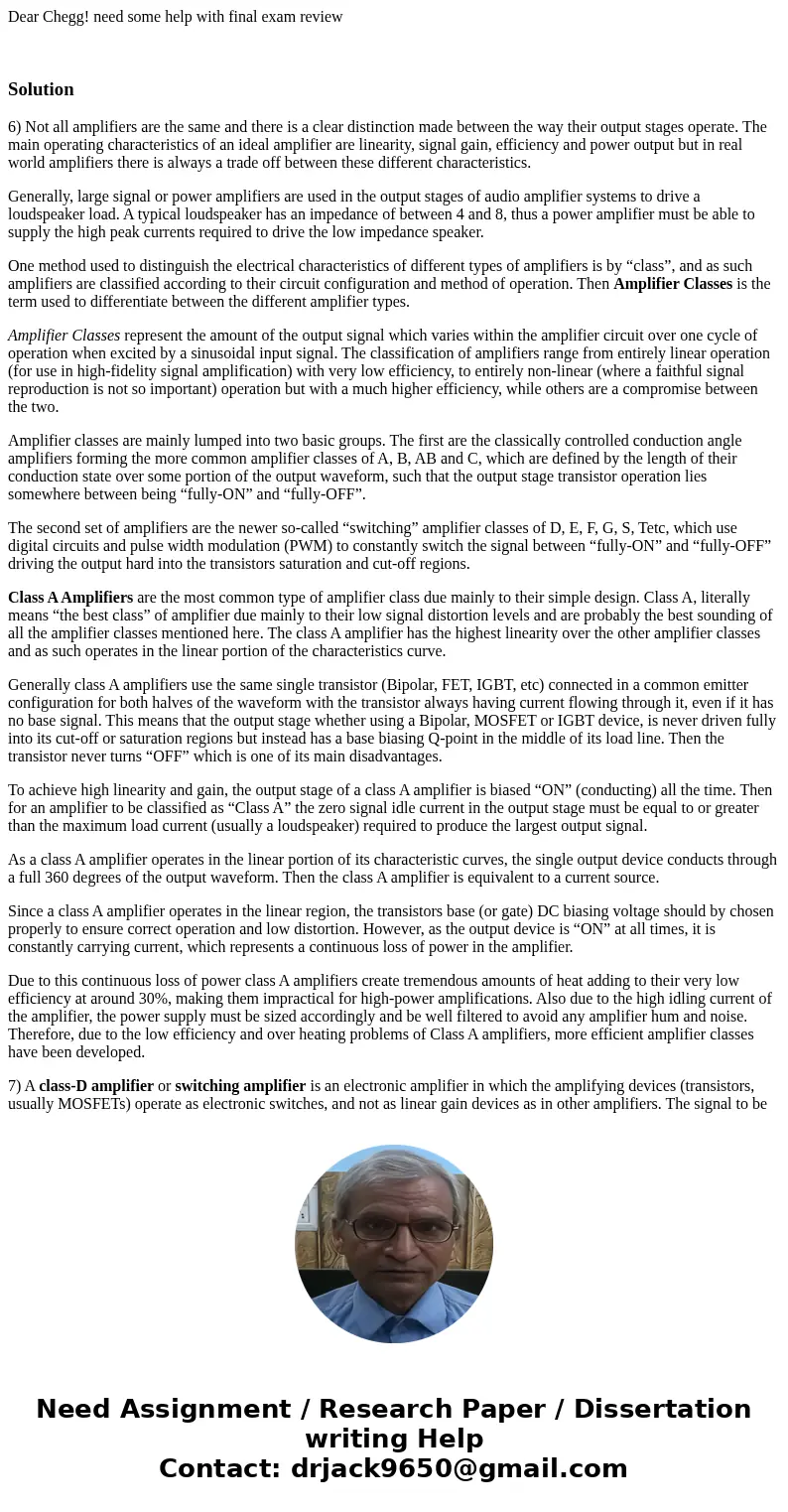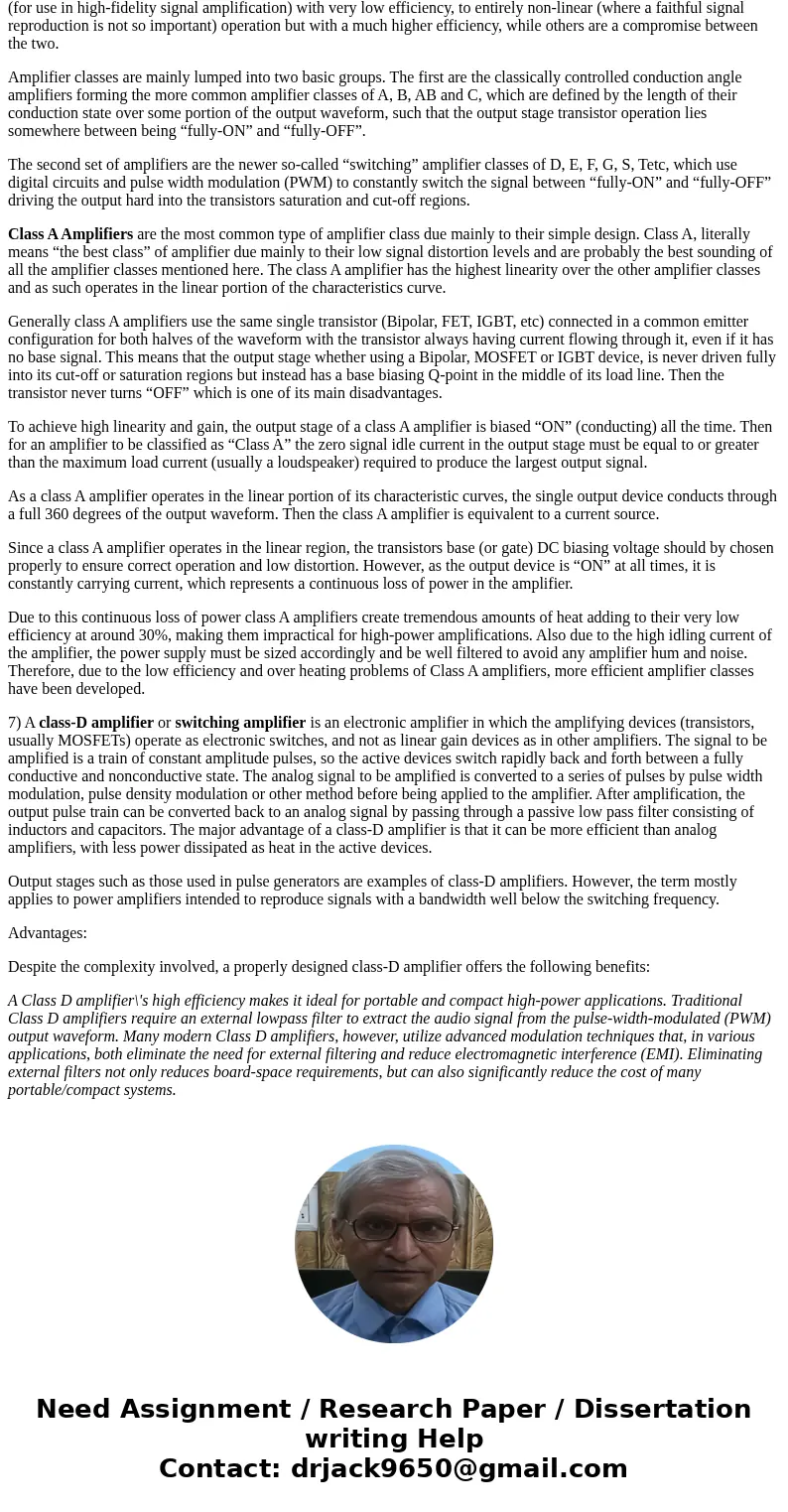Dear Chegg need some help with final exam review Solution6 N
Dear Chegg! need some help with final exam review
Solution
6) Not all amplifiers are the same and there is a clear distinction made between the way their output stages operate. The main operating characteristics of an ideal amplifier are linearity, signal gain, efficiency and power output but in real world amplifiers there is always a trade off between these different characteristics.
Generally, large signal or power amplifiers are used in the output stages of audio amplifier systems to drive a loudspeaker load. A typical loudspeaker has an impedance of between 4 and 8, thus a power amplifier must be able to supply the high peak currents required to drive the low impedance speaker.
One method used to distinguish the electrical characteristics of different types of amplifiers is by “class”, and as such amplifiers are classified according to their circuit configuration and method of operation. Then Amplifier Classes is the term used to differentiate between the different amplifier types.
Amplifier Classes represent the amount of the output signal which varies within the amplifier circuit over one cycle of operation when excited by a sinusoidal input signal. The classification of amplifiers range from entirely linear operation (for use in high-fidelity signal amplification) with very low efficiency, to entirely non-linear (where a faithful signal reproduction is not so important) operation but with a much higher efficiency, while others are a compromise between the two.
Amplifier classes are mainly lumped into two basic groups. The first are the classically controlled conduction angle amplifiers forming the more common amplifier classes of A, B, AB and C, which are defined by the length of their conduction state over some portion of the output waveform, such that the output stage transistor operation lies somewhere between being “fully-ON” and “fully-OFF”.
The second set of amplifiers are the newer so-called “switching” amplifier classes of D, E, F, G, S, Tetc, which use digital circuits and pulse width modulation (PWM) to constantly switch the signal between “fully-ON” and “fully-OFF” driving the output hard into the transistors saturation and cut-off regions.
Class A Amplifiers are the most common type of amplifier class due mainly to their simple design. Class A, literally means “the best class” of amplifier due mainly to their low signal distortion levels and are probably the best sounding of all the amplifier classes mentioned here. The class A amplifier has the highest linearity over the other amplifier classes and as such operates in the linear portion of the characteristics curve.
Generally class A amplifiers use the same single transistor (Bipolar, FET, IGBT, etc) connected in a common emitter configuration for both halves of the waveform with the transistor always having current flowing through it, even if it has no base signal. This means that the output stage whether using a Bipolar, MOSFET or IGBT device, is never driven fully into its cut-off or saturation regions but instead has a base biasing Q-point in the middle of its load line. Then the transistor never turns “OFF” which is one of its main disadvantages.
To achieve high linearity and gain, the output stage of a class A amplifier is biased “ON” (conducting) all the time. Then for an amplifier to be classified as “Class A” the zero signal idle current in the output stage must be equal to or greater than the maximum load current (usually a loudspeaker) required to produce the largest output signal.
As a class A amplifier operates in the linear portion of its characteristic curves, the single output device conducts through a full 360 degrees of the output waveform. Then the class A amplifier is equivalent to a current source.
Since a class A amplifier operates in the linear region, the transistors base (or gate) DC biasing voltage should by chosen properly to ensure correct operation and low distortion. However, as the output device is “ON” at all times, it is constantly carrying current, which represents a continuous loss of power in the amplifier.
Due to this continuous loss of power class A amplifiers create tremendous amounts of heat adding to their very low efficiency at around 30%, making them impractical for high-power amplifications. Also due to the high idling current of the amplifier, the power supply must be sized accordingly and be well filtered to avoid any amplifier hum and noise. Therefore, due to the low efficiency and over heating problems of Class A amplifiers, more efficient amplifier classes have been developed.
7) A class-D amplifier or switching amplifier is an electronic amplifier in which the amplifying devices (transistors, usually MOSFETs) operate as electronic switches, and not as linear gain devices as in other amplifiers. The signal to be amplified is a train of constant amplitude pulses, so the active devices switch rapidly back and forth between a fully conductive and nonconductive state. The analog signal to be amplified is converted to a series of pulses by pulse width modulation, pulse density modulation or other method before being applied to the amplifier. After amplification, the output pulse train can be converted back to an analog signal by passing through a passive low pass filter consisting of inductors and capacitors. The major advantage of a class-D amplifier is that it can be more efficient than analog amplifiers, with less power dissipated as heat in the active devices.
Output stages such as those used in pulse generators are examples of class-D amplifiers. However, the term mostly applies to power amplifiers intended to reproduce signals with a bandwidth well below the switching frequency.
Advantages:
Despite the complexity involved, a properly designed class-D amplifier offers the following benefits:
A Class D amplifier\'s high efficiency makes it ideal for portable and compact high-power applications. Traditional Class D amplifiers require an external lowpass filter to extract the audio signal from the pulse-width-modulated (PWM) output waveform. Many modern Class D amplifiers, however, utilize advanced modulation techniques that, in various applications, both eliminate the need for external filtering and reduce electromagnetic interference (EMI). Eliminating external filters not only reduces board-space requirements, but can also significantly reduce the cost of many portable/compact systems.


 Homework Sourse
Homework Sourse